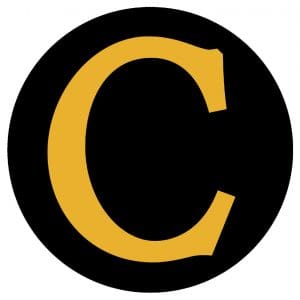Centre College and Walter Camp’s All-American Teams
Since early in the history of college football, it has been customary to pick the best players from across the country each year and designate them as All-Americans.
Over the years, there were various organizations, newspapers, and “football experts” who felt qualified to make annual picks which made up different All-American teams.
However, only one All-American team was accepted by consensus to be THE team which was felt to be the most coveted and recognized by players and fans of the sport, and that was the team selected by Walter Camp, who has been called "The Father of American Football.”

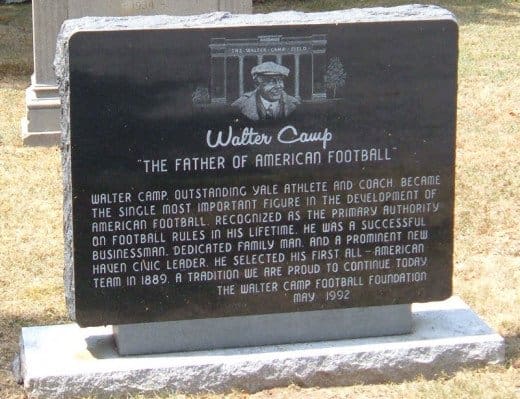
Walter Camp, recognized as "The Father of American Football"
Camp was born in New Britain, Connecticut on April 7, 1859, 10 years before the 1869, first college football game between Princeton and Rutgers.
He entered Yale in 1875 and played in the first game ever played between the Eli and Harvard in the fall of that year.
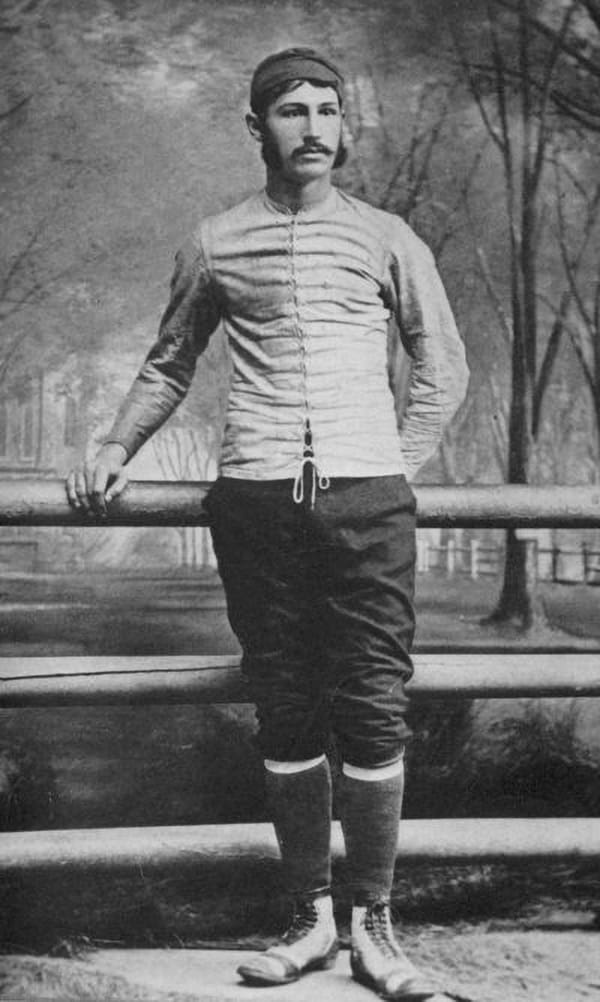
Walter Camp. Yale team captain, 1878-79
After graduating in 1880, Camp entered medical school which he attended until 1883, but the sight of blood made him faint, and he wisely changed career plans and went into his uncle's clock business, eventually becoming the president of the New Haven Clock Company in 1902.
While working in the clock business, he also coached the Yale football team from 1888-1892, compiling a 67-2 record during his 5 years at New Haven, claiming "national championships" in 1888, 1891, and 1892.
In late 1892, after the Bulldogs had completed a 13-0 season, Camp moved west and created the new Stanford University football program by offering his services free in order to popularize the game on the West Coast. He coached the new team during 3 games in late November and December that first year and then returned during 1894 and 1895, going 10-3-1 during his 2 full years there.
A memorable game was against Amos Alonzo Stagg's Chicago Maroons on December 25, 1894 in San Francisco which is considered the first ever, post-season, intersectional football game.
Chicago won 24-4 after the first half had ended in a scoreless tie.
Camp’s love of football led him later to devote many hours as the advisor to a succession of coaches at his alma mater after leaving coaching.
He also was forefront in trying to make the game safer.
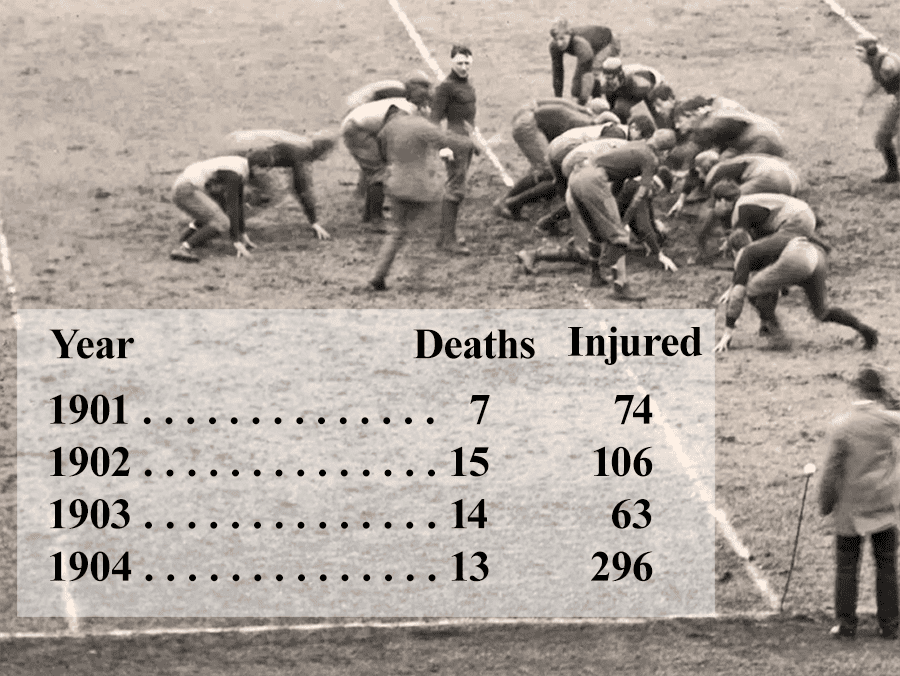
In 1904, deaths and injuries had exceeded 300 players and changes were necessary for the game to survive. The injuries were serious in nature and didn't include the common sprains and bruises.
The San Francisco "Call and Bulletin" republished a November 26, 1905 story which had been written by the Chicago "Tribune" about the gruesome statistics which were occurring on the gridirons across the nation with the mention that teams "with an open game have escaped with less than their usual quote of accidents."
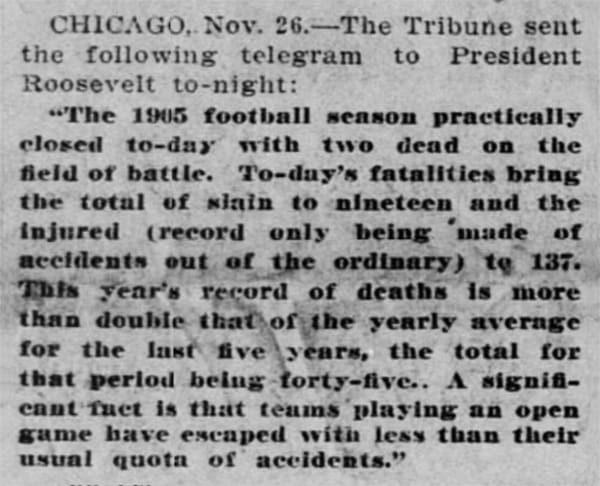
".........teams playing an open game have escaped their usual quota of accidents."
Football had become so rough, with an ever-increasing number of injuries and deaths that President Theodore Roosevelt invited a group of football devotees including Secretary of State, Elihu Root, the athletic directors of Harvard, Princeton, and Yale, along with Camp, to attend a December 9, 1905 White House meeting, and out of the old “Rough Rider’s” intervention, changes in the game’s rules were proposed to make it safer, including legalization of the forward pass, which opened up the game to make it less like rugby with its "three yards and a cloud of dust" approach which described the "flying wedge."

The dangerous "flying wedge"
Another of the suggestions made at the White House meeting was to increase the width of the playing field which was felt would make the game safer. That would have made Harvard's magnificent 1903 stadium obsolete as its field couldn't have been widened without totally rebuilding the Stadium, and it was rejected.
That was one of the deciding factors in deciding to adopt the forward pass.
Besides the decisions made at the Washington meeting, Camp, as one of the founding members of what would become the National Collegiate Athletic Association, the NCAA, was in the forefront of other decisions which determined that plays would be run from a line of scrimmage, along with the standardization of points allowed for touchdowns, extra points and field goals.
He was instrumental in designating that 11 players made up a team, what constituted a penalty, and how many yards should be forfeited for an infraction, along with other concepts which make the game what it is today.
Camp not only served on the NCAA rules committee from its inception, but was its chairman from 1911 until his death at age 65 from a heart attack while attending the committee’s annual meeting in 1925.
However, whatever Camp’s contributions were during the evolution of college football, it was for the development of an annual, All-American team that he is best known.The first ever All-American team was announced in 1889. There is no definite agreement if the idea was Camp’s or that of an individual named Casper Whitney who was the editor of a short-lived magazine named “This Week’s Sport.” However, Camp definitely was involved in naming the team after that first year and until his death over 3 decades later.
Obviously, Camp couldn’t attend every game played each week, so he devised a system where he would ask sportswriters, officials of games, and trusted athletic figures to be his “eyes and ears” during games, reporting their observations back to him.
The make-up of Camp’s team was kept a secret until it was announced in “Collier’s,” a now defunct, national weekly publication. Centre’s players, coaches, administration and most of Danville and Boyle County, eagerly awaited the December 13, 1919 issue of “Collier’s.”

After all, Walter Camp had proclaimed that he felt Centre had the top team in all of college football in 1919 due to its win over West Virginia, which trashed Princeton, 25-0, along with victories over Virginia and Indiana, on the way to a perfect 9-0 record.
Also, in the 1919 “Spalding’s Football Guide,” Camp had recognized the skills of Bo McMillin, Red Weaver, Red Roberts and other Colonels for their play during the 1918 season. Also, Eddie Mahan, Harvard's All-American, had written in the Boston "Post" that Centre deserved to be designated the best college football team in 1919.
However, Centre was concerned about its players being recognized simply because of the fact that the South had routinely been excluded when post-season awards were passed out regarding All-American honors.
Of Camp’s 18, All-American, first team selections since 1900, ( there was no team in 1917 due to the Great War ) of the 198 players, the breakdown was as follows:1. Yale | 47 |
2. Harvard | 39 |
3. Princeton | 21 |
Cell | Cell |
Total | 107 |

Thus, the “Big 3” had 54% of the total selected. This was understandable. The “Big 3” dominated football during that period, and that domination meant that those schools had the best material.
The rest of Camp’s selections were heavily weighed toward the East.
4. Pennsylvania | 14 |
5. Army | 9 |
6. Dartmouth | 8 |
7. Brown | 6 |
8. Navy | 5 |
9. Cornell | 4 |
9. Pittsburgh | 4 |
9. Syracuse | 4 |
9. Colgate | 4 |
13. Carlisle (Pa.) | 3 |
13. Columbia | 3 |
15. Amherst | 1 |
15. Penn State | 1 |
15. Rutgers | 1 |
Cell | Cell |
Total | 67 |
These additional programs, added to the “Big 3,” meant that colleges from the East had grabbed 174 positions, or 88% of the All-American selections.
All of the other programs outside of the East which had players who made the All-American squads were larger colleges which had significant student bodies far exceeding the numbers in Danville, Kentucky.
1. Michigan | 8 |
2. Chicago | 6 |
3. Minnesota | 4 |
4. Illinois | 2 |
5. Ohio State | 1 |
5. Wisconsin | 1 |
5. Georgia Tech | 1 |
5. Notre Dame | 1 |
Cell | Cell |
Total | 24 |
It didn’t take much analysis to see that a small college, especially a small college from the South, would have a tough time placing any of its players on Walter Camp’s All-American, first team.
The only such player from the South named since 1900 was 1918’s Ashel Monroe “Bum” Day of Georgia Tech, and Tech, with an enrollment of nearly 2500 at the time, was no small college like Centre with its student body of less than 200 during 1919-20.
Therefore, it was historic when Walter Camp’s All-American Team was announced for the 1919 season.

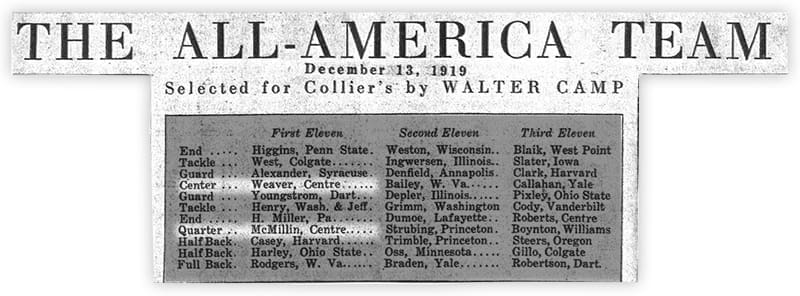
"First Eleven" position at Center... Weaver, Centre "First Eleven" position at Quarter... McMillin, Centre
Centre’s Alvin Nugent “Bo” McMillin was placed in the quarterback slot.

Centre’s James Redwich “Red” Weaver was the center.

Camp also picked second and third All-American teams each year.
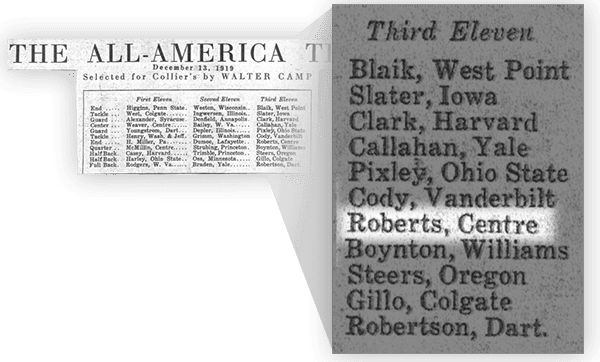
Centre’s James Madison “Red” Roberts was placed on the 3rd team at an end position in 1919.

Red Roberts, third team All-American end in 1919
Of the 33 players named in 1919 on the first, second and third teams, Centre had 3 picks. It is quite understandable that Centre was extremely proud of its All-American selections in 1919 as someone had indicated on the photo below regarding "the first team in football history to have 'three players on Walter Camp's All-American team.' " However, the fact is that other teams had more picks in the past. For instance, Yale had its entire first 11 honored in 1900 with 7 first team, 3 second team and one third team selection in a 12-0, "National Championship" season, and Harvard had 2 first team and 4 second team selections in a 10-1 season, with its only loss being in a season-ending loss to Yale that same year.

Bottom row- Red Weaver, 5th from left
Top row- Bo McMillin, 1st left Red Roberts, 5th left
No other college had over 2 selections in 1919, so whoever wrote on the photo was at least correct to a point.
Harvard, Yale and Princeton each had 2 as did Dartmouth, Ohio State, Colgate and West Virginia.
The following year, in 1920, Bo McMillin was Camp’s second team quarterback.
1920 All-American Teams

Bo McMillin was placed on Walter Camp's second team in 1920
In 1921, Centre had two selections with Red Roberts being placed on the first team at an end position and Bo again being named as the second team quarterback.
1921 All-American Teams

In 1921, Red Roberts was placed on Camp's first team at an end position
and Bo was again put on the second team at a quarterback position.
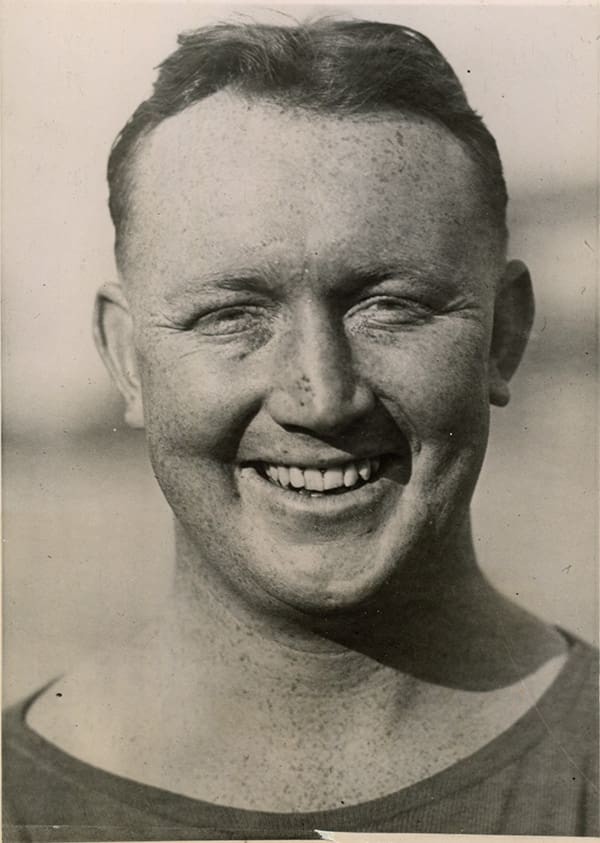
Red Roberts, 1st team end-1921
As has been previously noted, it is of particular interest that Bo McMillin, Red Weaver, and Red Roberts, all played high school football together in the fall of 1916 in Somerset, Kentucky as members of the "Briar Jumpers." How many small-town high schools can make the claim to have 3 All-American, college football players who played together at the same time? Also, how many high schools from the Southwest, such as Fort Worth North Side, could claim two first-team All-Americans during that time period who played on the same team as did Bo McMillin and Red Weaver?
To summarize Centre’s All-Americans:1919
Bo McMillin- first team, quarterback
Red Weaver- first team, center
Red Roberts- third team, end
1920
Bo McMillin- second team, quarterback
1921
Red Roberts- first team, end
Bo McMillin- second team, quarterback
After the Great War, the Centre College Colonels had truly put the little school on the national map in the world of college athletics as the United States entered the “Roaring Twenties.”
